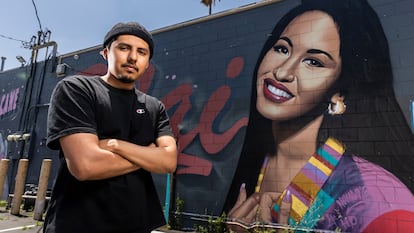In a single sentence, Rolando Hernández moves smoothly between English and Spanish. His narration is uninterrupted through shifts from one language to the other. He’s not doing it to translate what he’s saying; he simply takes for granted that the person listening to him will understand. The 26-year-old Cuban American is trilingual: he doesn’t just speak English and Spanish, but also Spanglish, a hybrid speech variety that was born out of the mix of Anglo and Hispanic cultures. In his Miami neighborhood of Hialeah, where three-quarters of residents are of Cuban descent and 95% of the population is Hispanic, Spanglish (in Spanish, Spanglish) rules: “It’s everywhere, from the closest McDonald’s drive-through to the galleries in Wynwood,” says Hernández.
Although it is hard to know the exact number of people who speak Spanglish, it’s estimated that there are 35 to 40 million people in the United States who, like Hernández, communicate with it, more than half of the 62 million Latinos who live in the country. It’s a number that will only grow as the Latino community expands over the coming years: by 2060, it is predicted that one in every four US residents will have Latino heritage. “It is the fastest-growing hybrid language in the world,” says Ilan Stavans, professor of Latinx and Latin American studies at Massachusetts’s Amherst College.
There are different kinds of Spanglish, depending on the country of origin of the community who speaks it. New York Puerto Ricans speak Nuyorican version, a Spanglish that combines Puerto Rican words with African American English, while Miami Cubans communicate in Cubonics and California Mexicans have their own, Chicano version. Aside from these differences, Spanglish usually manifests in one of three ways, explains Doctor José Medina, linguistic researcher and educational consultant, who works with school districts across the country to create and develop bilingual programs.
“The first kind of Spanglish is when you switch between the two languages,” says Medina. “That is to say, you can start in a language and quickly move to the other because that’s the way my mind works. The second way consists of combining words or taking a word in English and turning it into Spanish, or vice versa. Medina gives an example: “My favorite word is planinga mix between ironing and ironing.”
“And the third way of utilizing Spanglish is to focus on the syntactic, as when a student says in English, ‘The car blue is going fast.’ This doesn’t mean he doesn’t understand. It means that he understands too much, because he is using Spanish word order: the blue car. In Spanish, the noun always goes first and then the adjective, but in English, it’s different.”
For Medina, people who speak Spanglish have a “superpower”: translanguaging, or the ability to move fluently between several languages. “We all have a linguistic repertoire and our job is to utilize the parts of that linguistic repertoire that we need at different times. Translanguaging gives us the opportunity to understand that when we mix languages, it’s not incorrect. In truth, we are putting our knowledge on display at a high academic level because we can use both languages at the same time, something that not everyone can do,” he says.
Being ‘from here and there’
For decades, people who spoke Spanglish were looked down upon in the United States as well as their countries of origin. Many felt that they weren’t Puerto Rican or Mexican enough — but neither were they sufficiently “American.” On one hand, Latin American society told them that they were speaking a supposedly incorrect Spanish. On the other, in the United States they were reprimanded for not perfecting their English. Their latinidad — and identity in general — was constantly questioned, and Spanglish was seen as a halfway step in the process of assimilating into US culture and therefore English. Something temporary, something people would leave behind once they mastered the new language.

Hostility towards Spanglish was everywhere: it was born within migrant communities themselves, and even took shape in the family home. In Medina’s house when he was a child, his parents, who had emigrated from Ciudad Juárez, Mexico, to the United States, always told him to say it “in English or in Spanish.”
The educational system also played a major role in the demonization of Spanglish. Medina illustrates this fact with an anecdote about starting first grade in Texas at the end of the 1970s: “They didn’t just change my name from José to Joe, they also tried to force me to transition to English and to forget the Spanish language . They even tied me to a gurney. I peed myself and just like, on the urine-covered gurney, they brought me to my first-grade class.”
Faced with this generalized aversion, Spanglish prevailed as “a way to adapt oneself to the United States without losing one’s original culture,” says Ed Morales, professor at the Center for the Study of Ethnicity and Race at Columbia University in New York and author of the book Living in Spanglish (2002). For Morales, speaking Spanglish does not mean that a person is “neither from here nor from there” (neither from here nor there), but rather that “it’s about being from both places”, “being fluid.” “It’s a hybrid identity that takes parts from both, and moves towards the future,” he says. Stavans concurs: “Spanglish is not a step in the recognition process of learning English, but rather a that Latino culture has its own language that is not Spanish nor English.”
For Hernández, whose family emigrated from Cuba to Miami in 2007, Spanglish “was everything to try to fit into a new country.” His parents did not speak English and although there is much Spanish spoken in Miami, “there were educational and professional environments” in which his parents could not participate due to their
lack of English mastery. “It was a huge obstacle,” he says. For him and his sister, it was necessary to speak Spanglish at home in front of his parents so that “they could expand their vocabulary.” “But it was also important to keep the culture alive while at the same time, adapting to the new environment. Spanglish allowed us to do that,” he says.
Spanglish goes mainstream
The way of speaking that was born in the 19th century on the United States-Mexico border is, today, a global phenomenon. The first version of Spanglish was developed during the 1846-1848 Mexican-American war and its related conflicts. Spanglish continued to spread through yet another military clash: the Spanish-American War of 1898, when the United States established its control over much of the Caribbean. That moment was the start of “a great migration, in which comings and goings created a Hispanic milieu beyond the Caribbean in which the two languages mixed linguistically,” explains Stavans. This is how, throughout the 20th century, Spanglish grew its reach and went from being a borderlands dialect to an immigratory linguistic variety, with the arrival of thousands of Latin American migrants on US soil.

From these beginnings, and after all the rejection it has undergone, Spanglish “has moved from the periphery of culture to its center,” says Stavans. When the academic began to study the linguistic phenomenon, at the beginning of this century, he remembers that people would laugh at his work. “Nowadays, when I give a talk, people don’t laugh. People see it as something normal, they can be in favor of it or against it, but they no longer see it as something strange, something foreign. They see it as an everyday thing,” says the writer.
Stavans explains that this acceptance is due to “the media army” that broadcasts Spanglish. He’s referring to the theatrical productions, music heard around the world, movies, novels, children’s books and all kinds of artistic manifestations. Latino artists — most importantly, in reggaeton and other genres from the hip-hop diaspora — have brought Spanglish to the top of the musical charts, with lyrics that have propagated the use of Spanglish across the globe. Its presence is also felt on social media, apps and websites that promote its use and consumption, and many corporations and businesses have also adopted its use. “Toyota and Colgate have commercials in Spanglish, Hallmark has a line of cards in Spanglish,” says Stavans.
While linguistic mixes like portuñolfrom the border between Spain and Portugal, and frañol, from the French-Spanish border, are primarily used in the well-defined borderland regions, Spanglish has managed to go beyond borders and migratory paths to become a global phenomenon that has been exported to different countries. “If we add together the US population with the Latin American population who use it, there are some 50 million people who speak this language in one form or another,” says Stavans.

There is not correct Spanish
The Royal Spanish Academy (RAE) incorporated the term Spanglish (or Spanglish) to its dictionary in 2014, defining it as a “way of speaking of some Hispanic groups in the United States in which lexical and grammatical elements from Spanish and English mix.” Other words have also been incorporated, like the verb Parkwhich comes from “to park”; type, which means “to something type”; and check, which comes from “to check something.” Still, and despite the growth of Spanglish in recent years, some people continue to view it with disdain. In more conservative and traditional circles, Spanglish continues to be seen as no more than a way of sullying Spanish.
But for Stavans, “there is no correct language, there is the aspiration to a correct language, but to survive, they have always had to adapt.” “We have this utopic dream that there is a correct Spanish and that’s why there is an institution like the Royal Spanish Academy, which is supposed to protect Spanish. It’s curious that English, despite being one of the most popular languages in the world, does not have a Royal Academy,” says the expert. “English has institutions that are more descriptive than prescriptive: the Royal Academy tends to be prescriptive, which is to say, how one should speak Spanish, while in the United States, dictionaries are descriptive, they reflect how people speak. I think that Spanglish has developed with such dynamism thanks to English, because English does not aspire to squashing everything that comes from below, but instead to giving it some mobility and flexibility.”
Spanglish is also seen as a tool for decolonialization, and has a certain political backstory: “To put an end to the way that the Spanish want us to speak Spanish,” says Morales. Anywayfor the majority of the people who use it, Spanglish is a matter of identity and simplythe way they talk.
Credits
Text: Paola Nagovitch
Text editing: Ines Santaeul
alia
Images and video: Eva Marie Uzcategui, Carlos Rosillo, Brenda Maytorena Lara
Video editing: Angel Villegas
Visual editing: Hector Guerrero
Sign up for our weekly newsletter to get more English-language news coverage from EL PAÍS USA Edition
#Today #Spanglish #language #posing #threat #Anglocentrism #United #States
